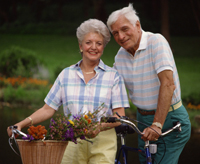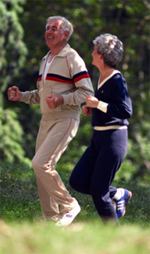
Seniors and Exercise
As we grow older we tend to become less active. This is often a slow process that leaves us overweight and out of shape before we know it. How can we stop this process? The first step toward a more active, healthy lifestyle is exercise.
Why is Exercise Important?A safe, effective exercise program can help reduce some of the aches and pains that are a part of getting older. It can also slow down the progression of conditions associated with aging. For example:
 © 2008, Jupiter Images Corp.
© 2008, Jupiter Images Corp.
- Keeping active helps you maintain your ability to walk, which is especially important to maintain your independence.
- Exercise can improve and maintain balance and posture, reducing your risk of falling.
- Exercise can improve your strength, endurance and flexibility. It promotes bone strength. Repeated mild stress on our bones helps them maintain their calcium content and structure.
- Exercise also helps to maintain muscle mass and tone. After age 30 we start losing muscle mass. Exercise stimulates muscle growth and slows this process. Muscle also uses more calories than fat tissue. As we increase or maintain our muscle mass we create a better 'metabolic machine' for burning calories.
- Exercise is also important for joint health. Repetitive motion promotes the body's natural process of lubricating joint surfaces. This may help lessen joint stiffness and achiness.
- The stronger your muscles are, the more weight and stress they can handle. Stronger muscles protect your joints. As we age our joints begin to gradually weaken from typical wear and tear. Stronger muscles take weight and stress away from your joints.
An effective exercise program is made up of several components: aerobic conditioning, flexibility and agility exercises, strength training, and relaxation techniques. Before starting an exercise program be sure to talk with your doctor, especially if you have a heart problem or history of heart disease.
 © 2008, Jupiter Images Corp.
© 2008, Jupiter Images Corp.
Aerobic Conditioning improves the health of your heart and lungs. It also helps to manage your weight. With aerobic exercise, you move continuously to increase your heart rate and keep it elevated for a sustained period of time. How long you can exercise aerobically will depend on your fitness level. A general guideline is to work up to 20 to 30 minutes a day, three to four days a week.
Choose activities that you enjoy and can do regularly. Common aerobic activities include walking, jogging, bicycling, swimming, low impact aerobic classes, water exercise classes, and dancing. Many people prefer using machines, such as a rowing machine, stair climber, treadmill, elliptical trainer, or stationary bicycle. All forms of dancing -- ballroom, social, country western -- are another great way to get moving!
If you have arthritis, consider low- to no-impact activities such as water aerobics, swimming, elliptical trainer, Nordic track, stationary bicycle, or rowing machine.
Flexibility and Agility Exercises are important for increasing your body's range of motion. They also help lessen muscle tension and soreness, and reduce your risk of injury. We often overlook stretching and range of motion exercises, but they are very important in maintaining overall fitness.
Stretching programs and activities like yoga or tai chi are good examples of flexibility and agility training. Balance training is important and may help prevent falls and, therefore, fall-related fractures.
Tai chi is a program of exercises, breathing, and movements based on ancient Chinese practices. Seniors who practice tai chi or yoga have fewer falls and less fear of falling. These classes can also increase self-confidence and improve body balance.
Strength Training improves muscular capacity and bone density. Stronger muscles and bones make it easier to do everyday activities like carry shopping bags or do yardwork.
 © 2008, Jupiter Images Corp.
© 2008, Jupiter Images Corp.
The most common strength training methods are working with free weights, resistance rubber bands or weight machines. It is very important to avoid strength imbalances by working all the major muscle groups, including the muscles in your arms, chest, back, stomach, hips, and legs.
If you have osteoporosis or loss of bone calcium, you will need to talk with a doctor before beginning a strength training program.
Relaxation techniques are important to include in your overall fitness program. Relaxation helps maintain overall cardiac fitness, lower blood pressure, and may even improve your immune system.
Many yoga classes include relaxation techniques like deep (diaphragmatic breathing) and simple meditation. Relaxation techniques can be as simple as sitting with your eyes closed and concentrating on controlled deep breathing.
Exercise Safely- Use common sense and don't exercise when you have a cough, fever, cold or flu. But don't let a temporary illness put a permanent stop to your exercising. Resume your activities as soon as you can.
- After an illness, start your exercise program at the beginning again. Do not immediately take up where you left off. Your body needs time to recover and rebuild. Consult a physician even if your illness is minor.
- Be alert to air quality if you work out at a gymnasium, especially if you have a lung condition such as asthma or bronchitis. Exercise at less-crowded times during the cold and flu season. Exercise outdoors whenever weather permits.
- If you live near an enclosed shopping mall, consider becoming a mall walker. Many malls open before the stores do and allow people to walk around. This allows you to exercise even if the weather is bad.
Source: http://orthoinfo.aaos.org/topic.cfm?topic=A00380
